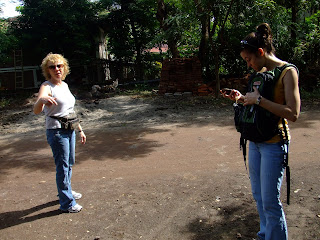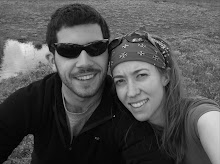There was a game included in the package called Bananagrams, where players make their own crossword puzzles with a bunch of letter tiles. It’s kind of like free-form Scrabble. Even though I used more letters, Jess still won. Here are our crosswords.
Matt´s:

Jess´s:

This week was the first of the new year where we really worked our butts off. I had an activity to run virtually every morning and afternoon and Jess juggled finishing up a grant proposal with some workshops for the health department. I worked 3 days this week with brigadistas, who are Nicaraguans who volunteer to help with the health department. We have about 300 brigadistas in the Municipality of Somoto, most of whom live very rurally. People from these communities have to walk 2 or 3 hours just to get to a health post. Health posts have a nurse most weekdays, but only have doctors 2 days a week. Clearly, there is a big deficit in the care that’s needed and the amount of coverage available. Therefore, it’s the brigadistas’ responsibility to diagnose an illness or injury and decide whether that injury warrants a trip to the health center. If the brigadista feels it’s serious enough, they give a referral to the person and send them on their way to the health center. Anyone can just show up at a health center, but a referral from a brigadista gets priority, so people in the communities turn to the brigadistas first, before making the trek. The system can only work if the brigadistas are well trained in basic medical care and know the signs for more serious illnesses. To make sure that’s the case PLAN Nicaragua, an international non-profit, offers monthly trainings to the brigadistas in 23 principal communities (about a third of all the brigadistas). This month’s training covered illnesses in infants and child nutrition. Because it’s the first of the year, we also talked about the logistics of reporting to the health center in Somoto.

To review the information we learned, I introduced a new game to the brigadistas: Jeopardy. We had 2 teams of 5 participants each, as well as a “studio audience” of about 30. It took a while for everyone to understand the rules, but once we got going, it worked out quite well. We didn’t make them answer in question form, but other than that it worked them same. The best part about the review was that we had virtually no wrong answers, which means the brigadistas were paying attention and were well trained. Overall, a success!

Saturday morning Jess, Astro and I climbed a little mountain peak on the outskirts of Somoto called La Montaña de la Cruz. Going up took about an hour, but once we made it we had a bird’s eye view of our city and the surrounding countryside. The whole trip only took about 3 hours, but it was great excerise. One of our New Year’s resolutions was to visit all the pretty sights to see around Somoto. Slowly, but surely, we’re scratching them off the list! Here are the pictures from our trip to the Cross.
The view from downtown Somoto. Can you make out the cross at the peak?

Halfway up the mountain at about 7:00 AM.

Taking a break on the way up.

Looking down at Somoto from the peak.

Our house is somewhere down there!

Sometimes you have to climb a few fences to get where you want to go!

Looking South-East from the peak.

And in other news, our good friends Akhnaton and Silvia welcomed their third child into the world on the 13th! Their first boy (blog readers might remember Adriana and her sister Ena Sophia from previous posts), he’s named Akhnatontito (little Akhnaton) Corrales Espinoza. He weighed in at 8 lbs. 3 oz, and wakes up every 30 minutes crying to be fed. How exciting!




 The fruity pulp is left to decompose and then is scattered among the coffee plants as a form of fertilizer. As the beans dry in the sun, workers pick through each batch and remove any shells or deformed beans. What’s left is bagged, put on mules, and taken down the mountain to be sold in Estelí. The coffee won’t get roasted until it makes it to its final destination, so at this stage it’s still very yellow, and the Nicas call it “café oro” or gold coffee.
The fruity pulp is left to decompose and then is scattered among the coffee plants as a form of fertilizer. As the beans dry in the sun, workers pick through each batch and remove any shells or deformed beans. What’s left is bagged, put on mules, and taken down the mountain to be sold in Estelí. The coffee won’t get roasted until it makes it to its final destination, so at this stage it’s still very yellow, and the Nicas call it “café oro” or gold coffee. 

 Once the mud has dried for a week the board can be removed and the oven is ready for use. You may be asking, “what makes this stove any better?” Good question!
Once the mud has dried for a week the board can be removed and the oven is ready for use. You may be asking, “what makes this stove any better?” Good question!




 Jess and I would like to wish everybody a fantastic 2009! We have some new year´s resolutions to share with you all, but first we´d like to describe the festivities that took place in Somoto.
Jess and I would like to wish everybody a fantastic 2009! We have some new year´s resolutions to share with you all, but first we´d like to describe the festivities that took place in Somoto. Then the whole thing is cooked down and served over rice with bread. It´s tough to compare the taste to anything we have back home, except for maybe a pulled pork sandwich without the barbecue sauce. It was very rich, to say the least.
Then the whole thing is cooked down and served over rice with bread. It´s tough to compare the taste to anything we have back home, except for maybe a pulled pork sandwich without the barbecue sauce. It was very rich, to say the least.
















